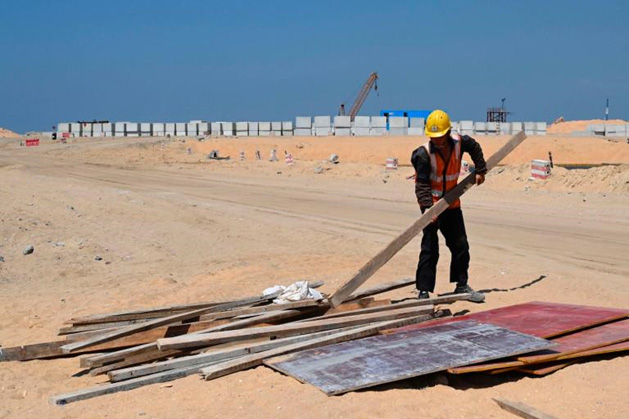As the pandemic rages, China’s strategy is becoming more high-tech and sophisticated.
The past two years have not been kind to the Belt and Road Initiative, the signature infrastructure project of Chinese President Xi Jinping. First, the United States labeled the initiative a “debt trap”—a loan-shark scheme for luring poor countries into economic vassalage—and began to pressure its allies and partners to stay away. Then came COVID-19. Last summer, China’s Ministry of Foreign Affairs admitted that as much as 60 percent of Belt and Road projects have been impacted to some degree by the pandemic. That figure is surely higher now. New Chinese overseas lending has fallen precipitously. This year, as low-income countries face a debt crunch, Chinese lenders could take enormous losses.
But the Belt and Road Initiative hasn’t died of COVID-19. On the contrary, Xi and other senior Chinese officials continue to trumpet the initiative. Their messaging is highly consistent: In 2021, China will start to wind down its new investment into traditional capital-intensive infrastructure, both at home and abroad. In that way, the pandemic provides an excuse to cut losses on unviable projects. Instead, the initiative will refocus on public health (especially vaccines), green technology, and digital services. This fresh-faced Belt and Road—higher-tech and more geared toward trade than investment—will fit neatly into China’s new “dual circulation” economic concept, which emphasizes Chinese domestic consumption. It will also be more attractive to partner countries than its previous incarnation.
China’s plans were made clear in remarks this past November by Meng Wei, a spokesperson for the National Development and Reform Commission, which oversees Belt and Road projects. Even as she insisted that the program “has shown full resilience … in the face of the pandemic,” she mostly focused her talk on “new breakthroughs on the Health Silk Road.” More and more countries, she said, “have seen the cooperation opportunities of the Health Silk Road, the Digital Silk Road, and the Green Silk Road.” Ning Jizhe, the commission’s vice chairman, elaborated on her comments in a follow-up speech in Hong Kong.
“The pandemic provides an excuse to cut losses on unviable projects. Instead, the initiative will refocus on public health, green technology, and digital services.”
The “Health Silk Road”—the COVID-19 vaccine race—is Beijing’s top priority. China wants to be seen as a responsible high-tech superpower that will help the world conquer the pandemic, not as a shady authoritarian regime that unleashed it. And China has a first-mover advantage in distributing its vaccines in non-Western countries. Vaccine makers Sinopharm and Sinovac are already delivering millions of doses everywhere from Indonesia to the United Arab Emirates. Throughout the pandemic, Xi positioned the Chinese vaccine as a “global public good.” This implies that China will heavily subsidize foreign buyers and favor China’s long-standing Belt and Road partners.
The “Green Silk Road” is another way China can burnish its international image while peddling its high-tech products abroad. China’s recent pledge to become carbon neutral by 2060 doubles as an industrial policy: It plans deepen its dominance in the fast-growing overseas market for wind turbines, photovoltaics, electric vehicles, lithium-ion batteries, and smart grid technologies. In 2019, over 70 percent of solar photovoltaics manufactured worldwide were made in China. China also controls up three-quarters of global manufacturing capacity for lithium-ion battery cells. These are some of the world’s fast-growing manufacturing industries: 72 percent of net new electricity generating capacity installed worldwide in 2019 was renewable.
Finally, a renewed push for the “Digital Silk Road,” launched in 2016, will support the international expansion of private Chinese tech companies under close supervision by the Communist Party. China now accounts for 23 percent of global cross-border data flows—mostly thanks to use of Chinese apps and services in Japan and Southeast Asia. This is almost double the U.S. share. China is also rolling out a world-leading digital renminbi with the goal of collecting more data and weakening the dominance of the U.S. dollar. Some Chinese tech companies are exporting “smart city technologies.” Others are offering integrated city or “country-as-a-platform” solutions, which could be a euphemism for exporting China’s techno-authoritarian toolkit.
By refocusing on these three priorities, the new Belt and Road Initiative will fit cleanly into China’s domestic post-pandemic macroeconomic strategy, known as “dual circulation.” Under the leadership of economic czar Liu He, China is finally reconsidering the debt-fueled growth model that has driven its development for over a decade. As Liu argued in the People’s Daily, in 2021 China should instead focus on stimulating household consumption, including of low-value imported goods, while boosting exports of higher-tech products. Such reforms, Liu has long argued, will “de-risk” China’s financial system; as Beijing’s overseas debtors clamor for loan forgiveness, it makes less and less sense for China to lend indiscriminately to high-risk countries like Pakistan and Venezuela.
Most of China’s trading partners find this new Belt and Road compelling—it’s a formula for rapid post-pandemic economic normalization. And they are already benefiting. Chinese imports reached a historic high in 2020, thanks to a stronger renminbi. From a Chinese perspective, meanwhile, this higher-tech Belt and Road, more focused on trade than on investment, is more sustainable than the chaotic, high-risk, debt-dependent model that preceded it.
This article retrieved from: https://foreignpolicy.com/2021/01/06/coronavirus-hasnt-killed-belt-and-road/, 2:43 PM Jakarta Time.
